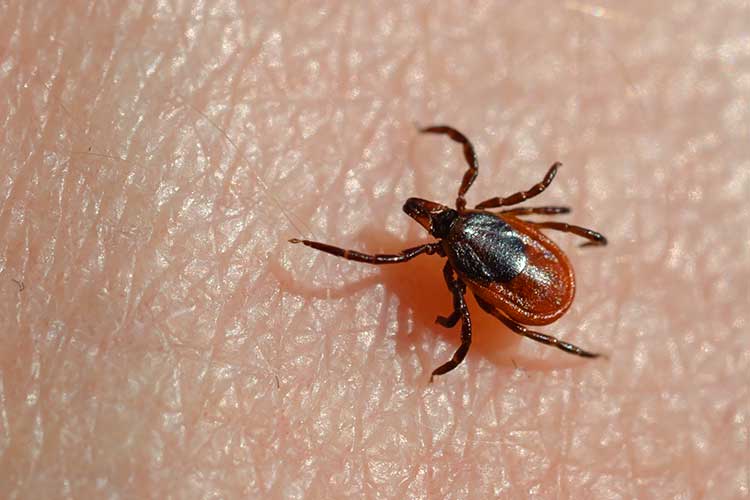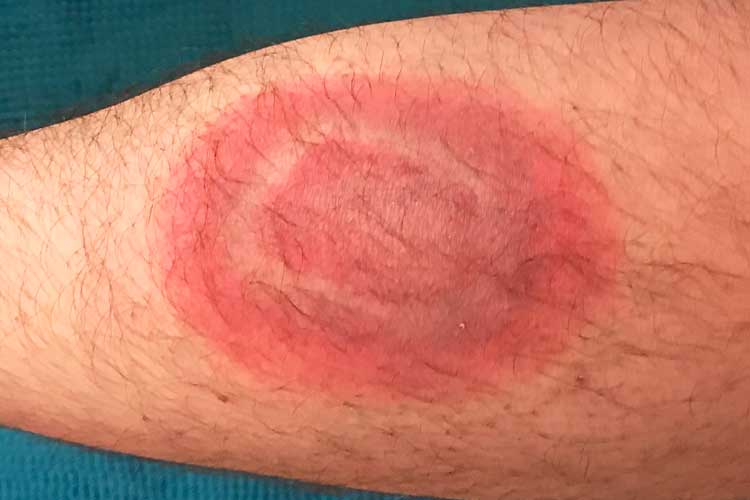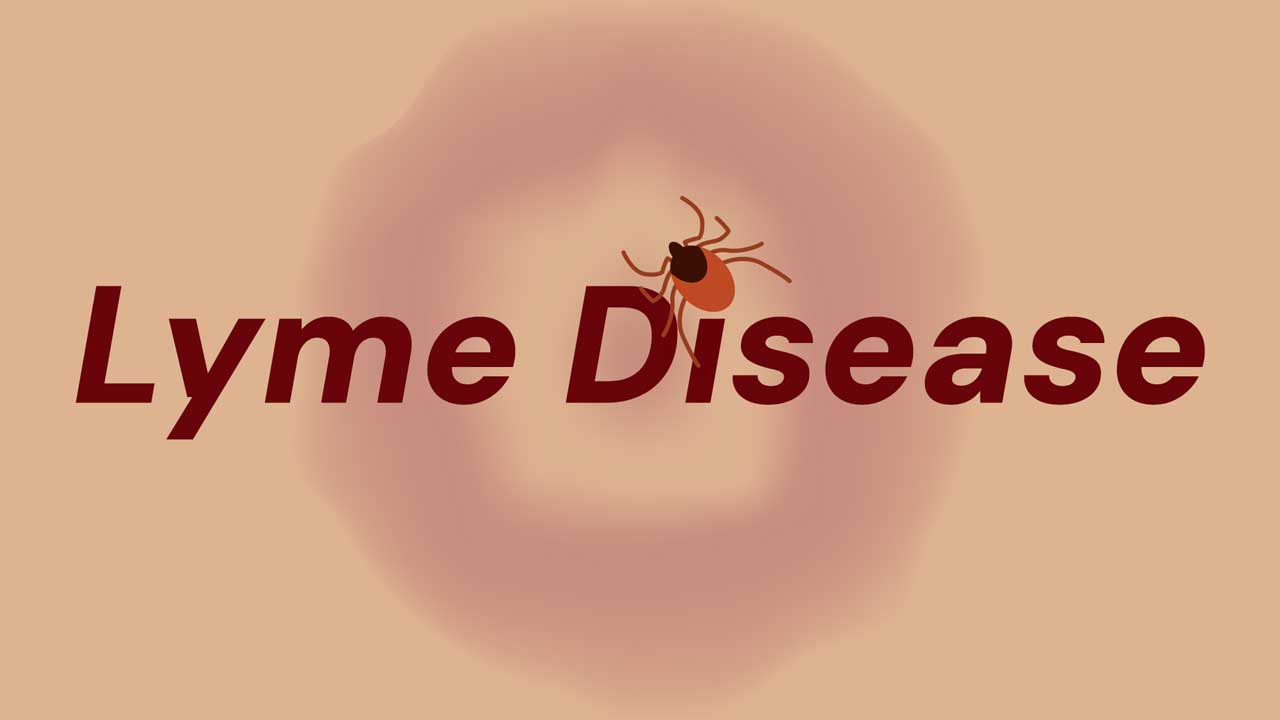What is Lyme Disease?
Lyme disease (also known as Lyme borreliosis) is a bacterial infection transmitted through tick bites (Skar et al. 2024).
It is a potentially multi-systemic condition that, if left untreated, may lead to serious symptoms (Skar et al. 2024).
The illness is predominantly caused by four types of bacteria in the Borrelia burgdorferi sensu lato group:
- B. burgdorferi (found in North America, Europe and Asia)
- B. mayonii (found in North America)
- B. afzelii (found in Europe and Asia)
- B. garinii (found in Europe and Asia).
(NSW Health 2023; Skar et al. 2024)
How Does Lyme Disease Spread?

Lyme disease is spread through ticks that become infected with Borrelia by feeding on the blood of certain wild mammals that naturally carry the bacteria, particularly white-footed mice (Dehhaghi et al. 2019; Bush & Vazquez-Pertejo 2025).
Borrelia survives in the tick’s midgut and can infect humans and animals through bites. Generally, the tick must be attached to a host’s skin for at least 24 hours (usually 36 to 48 hours) in order for Borrelia to be transmitted. Ticks are often encountered in high grass, brush, woodlands and forests (DoHaAC 2023; CDC 2024a).
Most cases of Lyme disease are caused by nymphs - immature (young) ticks - as they are about the size of a poppy seed and are therefore less likely to be discovered and removed before the Borrelia can be transmitted to the host (CDC 2024a).
The main vectors (carriers) of Borrelia are certain species of ticks from the Ixodidae family (hard-bodied ticks). These species include:
- North America:
- Ixodes scapularis (deer tick or black-legged tick)
- I. pacificus (western black-legged tick)
- Europe and Asia:
- I. ricinus (castor bean tick)
- I. hexagonus (hedgehog tick)
- I. persulcatus (taiga tick).
(Ngan & Vanousova 2015; Skar et al. 2024)
None of the above tick species are found in Australia (DoHaAC 2023).
The existence of locally acquired Lyme disease in Australia is a controversial and widely debated topic. Currently, the Australian Government does not support the diagnosis of locally acquired Lyme disease (DoHaAC 2023).
It is not possible for Lyme disease to spread between people (NSW Health 2023).

Symptoms of Lyme Disease
The most typical symptom of Lyme disease is erythema migrans, a red expanding rash that often resembles a bullseye. Erythema migrans occurs in about 70 to 80% of Lyme disease presentations and usually appears at the site of the tick bite after 7 to 14 days (Skar et al. 2024; CDC 2024a).
In most cases, erythema migrans is not painful or itchy but may feel warm to the touch. It may gradually expand in diameter over a period of days or weeks (Skar et al. 2024; CDC 2024).
Stages of Lyme Disease
There are three stages of Lyme disease. If left untreated, it will progress along these stages:
| Stage | When Does it Occur? | Possible Symptoms |
|---|---|---|
| 1. Early Stage | Within 30 days of the tick bite |
|
| 2. Early Dissemination | 3 to 12 weeks after the initial infection |
|
| 3. Late Dissemination | Months or years after the initial infection |
|
(Skar et al. 2024; DoHaAC 2023)
Diagnosing Lyme Disease

In earlier stages, Lyme disease may be diagnosed using physical symptoms (e.g. the presence of erythema migrans) and the possibility of exposure to infected ticks (NSW Health 2023).
Diagnosing late-stage Lyme disease requires complex laboratory testing and specialist expertise. Tests must only be performed by institutions that are accredited by the National Association of Testing Authorities (NATA) (NSW Health 2023).
Laboratory tests generally involve screening for relevant antibodies using the enzyme-linked immunosorbent assay (ELISA) test. These results are then confirmed using a western blot test (NSW Health 2023).
Treating Lyme Disease
Lyme disease is treated using antibiotics. If recognised and addressed early, about 80% of patients are able to make a full recovery (Skar et al. 2024).
However, if treatment is delayed, the patient is less likely to recover completely. In some cases, they may experience long-term symptoms such as arthritis, fatigue, headaches and neurological issues even after successful treatment (Ngan & Vanousova 2015; Bush & Vazquez-Pertejo 2025).
Preventing Lyme Disease
Lyme disease can be prevented by avoiding tick bites. If spending time in areas where Lyme disease-carrying tick species live, consider the following strategies:
- Wear appropriate clothing when outdoors (long-sleeved shirts, long pants tucked into socks, wide-brimmed hat)
- Wear lighter-coloured clothing, as ticks will be easier to see
- Spray clothes and hats with insect repellent
- Wear a DEET or picaridin repellent
- Keep to the centre of cleared paths if possible
- Try not to brush up against plants and grass
- Upon returning from an area where ticks live, remove all clothes and search for any ticks on the skin in good lighting. Make sure to check:
- Under the arms
- In and around ears
- Inside the navel
- Back of the knees
- In and around the hair
- Between the legs
- Around the waist
- Check children and pets for ticks
- Remove any ticks from skin or clothes as soon as possible
- Shower within two hours of returning
- Wash clothes in hot water and tumble dry on high heat.
(NSW Health 2023; CDC 2024b)
Removing Ticks
The safest way to remove a tick is to kill it with an ether-containing spray and allow it to fall off naturally. Do not attempt to remove a tick with tweezers (Healthdirect 2024).
Test Your Knowledge
Question 1 of 3
How long must a tick stay attached for in order to infect the host with Borrelia bacteria?
Topics
Further your knowledge
References
- Bush, LM & Vazquez-Pertejo, MT 2025, Lyme Disease, MSD Manual, viewed 22 April 2025, https://www.msdmanuals.com/en-au/home/infections/bacterial-infections-spirochetes/lyme-disease
- Centers for Disease Control and Prevention 2024a, Lyme Disease, U.S. Department of Health and Human Services, viewed 22 April 2025, https://www.cdc.gov/lyme/index.html
- Centers for Disease Control and Prevention 2024b, Preventing Tick Bites, U.S. Department of Health and Human Services, viewed 22 April 2025, https://www.cdc.gov/ticks/prevention/index.html
- Department of Health and Aged Care 2023, Overseas-acquired Tick-borne Diseases: Lyme Disease, Australian Government, viewed 22 April 2025, https://www.health.gov.au/resources/publications/overseas-acquired-tick-borne-diseases-lyme-disease-0?language=en
- Dehhaghi, M, Panahi, HZS, Holmes, EC, et al. 2019, ‘Human Tick-Borne Diseases in Australia’, Frontiers in Cellular and Infection Microbiology, vol. 9, no. 3, viewed 22 April 2025, https://www.ncbi.nlm.nih.gov/pmc/articles/PMC6360175/
- Healthdirect 2024, Tick Bites, Australian Government, viewed 22 April 2025, https://www.healthdirect.gov.au/tick-bites
- NSW Health 2023, Lyme Disease Fact Sheet, New South Wales Government, viewed 22 April 2025, https://www.health.nsw.gov.au/Infectious/factsheets/Pages/lyme_disease.aspx
- Ngan, V & Vanousova, D 2015, Lyme Disease, DermNet, viewed 22 April 2025, https://dermnetnz.org/topics/lyme-disease/
- SA Health 2022, Lyme Disease - Including Symptoms, Treatment and Prevention, Government of South Australia, viewed 22 April 2025, https://www.sahealth.sa.gov.au/wps/wcm/connect/public+content/sa+health+internet/conditions/infectious+diseases/lyme+disease/lyme+disease+-+including+symptoms+treatment+and+prevention
- Skar, GL, Blum, MA & Simonsen, KA 2024, ‘Lyme Disease’, StatPearls, viewed 22 April 2025, https://www.ncbi.nlm.nih.gov/books/NBK431066/
 New
New 

